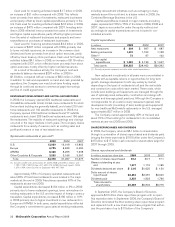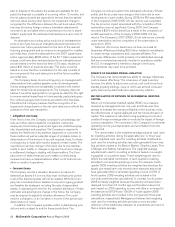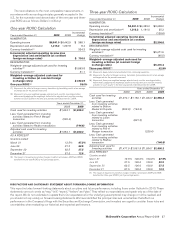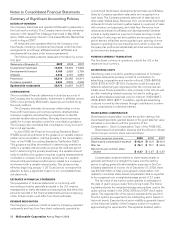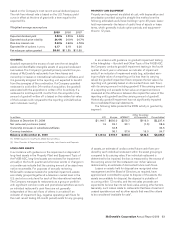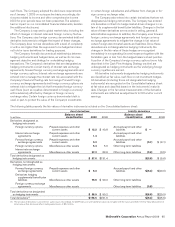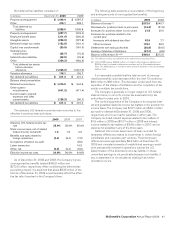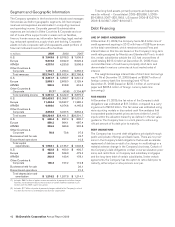McDonalds 2009 Annual Report Download - page 34
Download and view the complete annual report
Please find page 34 of the 2009 McDonalds annual report below. You can navigate through the pages in the report by either clicking on the pages listed below, or by using the keyword search tool below to find specific information within the annual report.
Notes to Consolidated Financial Statements
Summary of Significant Accounting Policies
NATURE OF BUSINESS
The Company franchises and operates McDonald’s restaurants in
the food service industry. The Company had a minority ownership
interest in U.K.-based Pret A Manger that it sold in May 2008,
and a 100% ownership interest in U.S.-based Boston Market that
it sold in August 2007.
All restaurants are operated either by the Company or by
franchisees, including conventional franchisees under franchise
arrangements, and foreign affiliated markets (affiliates) and
developmental licensees under license agreements.
The following table presents restaurant information by owner-
ship type:
Restaurants at December 31, 2009 2008 2007
Conventional franchised 19,020 18,402 17,634
Developmental licensed 3,160 2,926 2,756
Affiliated 4,036 4,137 4,081
Franchised 26,216 25,465 24,471
Company-operated 6,262 6,502 6,906
Systemwide restaurants 32,478 31,967 31,377
CONSOLIDATION
The consolidated financial statements include the accounts of
the Company and its subsidiaries. Investments in affiliates owned
50% or less (primarily McDonald’s Japan) are accounted for by
the equity method.
The Company evaluates its business relationships such as
those with franchisees, joint venture partners, developmental
licensees, suppliers, and advertising cooperatives to identify
potential variable interest entities. Generally, these businesses
qualify for a scope exception under the consolidation guidance.
The Company has concluded that consolidation of any such enti-
ties is not appropriate.
In June 2009, the Financial Accounting Standards Board
(FASB) issued amendments to the guidance on variable interest
entities and consolidation, codified primarily in the Consolidation
Topic of the FASB Accounting Standards Codification (ASC).
This guidance modifies the method for determining whether an
entity is a variable interest entity as well as the methods permit-
ted for determining the primary beneficiary of a variable interest
entity. In addition, this guidance requires ongoing reassessments
of whether a company is the primary beneficiary of a variable
interest entity and enhanced disclosures related to a company’s
involvement with a variable interest entity. This guidance was
effective beginning January 1, 2010, and we do not expect the
adoption to have a significant impact on our consolidated finan-
cial statements.
ESTIMATES IN FINANCIAL STATEMENTS
The preparation of financial statements in conformity with
accounting principles generally accepted in the U.S. requires
management to make estimates and assumptions that affect the
amounts reported in the financial statements and accompanying
notes. Actual results could differ from those estimates.
REVENUE RECOGNITION
The Company’s revenues consist of sales by Company-operated
restaurants and fees from franchised restaurants operated by
conventional franchisees, developmental licensees and affiliates.
Sales by Company-operated restaurants are recognized on a
cash basis. The Company presents sales net of sales tax and
other sales-related taxes. Revenues from conventional franchised
restaurants include rent and royalties based on a percent of sales
with minimum rent payments, and initial fees. Revenues from
restaurants licensed to affiliates and developmental licensees
include a royalty based on a percent of sales, and may include
initial fees. Continuing rent and royalties are recognized in the
period earned. Initial fees are recognized upon opening of a res-
taurant or granting of a new franchise term, which is when the
Company has performed substantially all initial services required
by the franchise arrangement.
FOREIGN CURRENCY TRANSLATION
The functional currency of operations outside the U.S. is the
respective local currency.
ADVERTISING COSTS
Advertising costs included in operating expenses of Company-
operated restaurants primarily consist of contributions to
advertising cooperatives and were (in millions): 2009–$650.8;
2008–$703.4; 2007–$718.3. Production costs for radio and
television advertising are expensed when the commercials are
initially aired. These production costs, primarily in the U.S., as well
as other marketing-related expenses included in selling, gen-
eral & administrative expenses were (in millions): 2009–$94.7;
2008–$79.2; 2007–$87.7. In addition, significant advertising
costs are incurred by franchisees through contributions to adver-
tising cooperatives in individual markets.
SHARE-BASED COMPENSATION
Share-based compensation includes the portion vesting of all
share-based payments granted based on the grant date fair value
estimated in accordance with the provisions of the
Compensation – Stock Compensation Topic of the FASB ASC.
Share-based compensation expense and the effect on diluted
net income per common share were as follows:
In millions, except per share data 2009 2008 2007
Share-based compensation expense $112.9 $112.5 $142.4
After tax $ 76.1 $ 75.1 $ 94.9
Net income per common share-
diluted $ 0.07 $ 0.07 $ 0.07
Compensation expense related to share-based awards is
generally amortized on a straight-line basis over the vesting
period in selling, general & administrative expenses in the Con-
solidated statement of income. As of December 31, 2009, there
was $100.9 million of total unrecognized compensation cost
related to nonvested share-based compensation that is expected
to be recognized over a weighted-average period of 2.1 years.
The fair value of each stock option granted is estimated on
the date of grant using a closed-form pricing model. The follow-
ing table presents the weighted-average assumptions used in the
option pricing model for the 2009, 2008 and 2007 stock option
grants. The expected life of the options represents the period of
time the options are expected to be outstanding and is based on
historical trends. Expected stock price volatility is generally based
on the historical volatility of the Company’s stock for a period
approximating the expected life. The expected dividend yield is
32 McDonald’s Corporation Annual Report 2009


